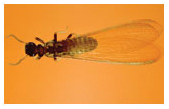By Dave Picton
The Termite Institute, an informative online resource created by the makers of Termidor® termiticide, offers a U.S. map depicting termite “hot zones.” Most of the state of California is depicted on that map, indicating “high homeowner risk” for termite infestation.
In our Sacramento pest control region, the most common type of termite is the Western Subterranean Termite, an  insect that also holds the title of most destructive termite in California, according to the University of California Statewide IPM Program.
insect that also holds the title of most destructive termite in California, according to the University of California Statewide IPM Program.
Now that warm, sunny days have arrived, it’s increasingly likely that homeowners may see termite swarms. Often, the visible swarm is the first evidence the homeowner has that he or she has a termite problem. But just because you don’t see a swarm doesn’t mean you don’t have termites.
In fact, the Western Subterranean Termite swarms only after a colony has been established for four years or more. The damage the termites cause to your home or commercial building occurs year-round, not just when you can see the swarmers. These termites can get into your building through cracks smaller than 1/16th of an inch large and can even come up through tiny fissures in the concrete slab. This type of termite needs moisture and contact with the soil. It builds tunnels of mud and sawdust or wallboard fragments, and sometimes you can spot the tunnels running up the side of your foundation.
Although the Western Subterranean termite is most common, there are several other types of termites that may infest our Sacramento-region homes, including the Nevada Dampwood Termite, which can occur in our Sierra foothill and mountainous areas. Drywood termites are more common in Southern California but also can occur in our Sacramento Valley environments.
Termite treatment and damage repair is a $5 billion problem in the United States. The best way to determine whether your home or commercial property is at risk for termite infestation or damage is to consult a licensed pest control professional. For more information about California termites, see our March 2010 article.

